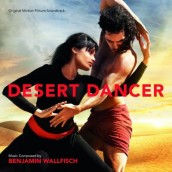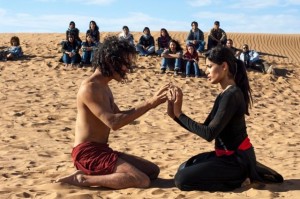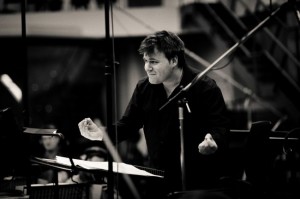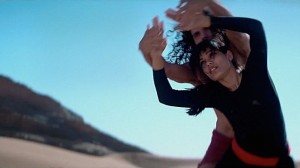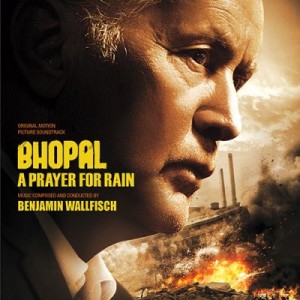More than ever, the regions of the Middle East and Asia are the tragic grounds for thousands of people trying to make better lives for themselves in the face of religious repression and grinding poverty. This is the musical link when it comes to Benjamin Wallfisch expressing the souls of Iran and India in his immensely moving, reality-based scores to DESERT DANCER and BHOPAL: A PRAYER FOR RAIN. The first speaks for the struggle of Afshin Ghaffarian, a young man whose spirit refuses to stay still for the murderous, moral police that stand for his country’s Islamist government – a passion for dance that drives him and his troupe into the beautiful, sand-swept wastes where they can express their true spirits. The second score is the deceptively beautiful, multinational-entranced lead up to the worst unnatural disaster to befall India, as interlinked characters hoping for the future in an ill-maintained American chemical plant instead receive terrible fates that spew out from its toxic clouds.
An Emmy-nominated composer whose striking work has received numerous awards justifiably touting him as a musical discovery, the England-born Wallfisch made an auspicious orchestral debut depicting the American gun craze of 2004’s DEAR WENDY, continuing to show a versatility of styles that ranged from THE ESCAPIST‘s percussive prison breakout to the emotional desperation of Paul Walker’s flood-distraught father in HOURS and the pained elegance of Edwardian artists for SUMMER IN FEBRUARY. But it’s been the way that Wallfisch has depicted “world” music that’s been particularly striking, from Viking death metal for HAMMER OF THE GODS to the symphonically rocking adventure of a Turkish warlord in CONQUEST 1453.
But while these ethnically-inclined scores were musical forces of often brutal nature, what particularly distinguishes DESERT DANCER and BHOPAL are their beautifully muted approaches that mainly use the thematically orchestral sound of “western music” to convey their universally emotional language, all while subtly including their respective country’s ancient instruments. Yet if they start softly with a poignantly mournful tone, Wallfisch is sure to raise the dramatic stakes, from the expressive hand movements that turn into pounding desert drums to the surge of panicked, sorrowful strings that unleash a wave of fog-filled terror. What’s particularly striking about DESERT DANCER is that where American dance movies rely on songs for their giant choreography, it’s Wallfisch’s score itself that drives the DESERT‘s soulful movement. Equally notable is the eerie Karmic sense of destiny that fuels BHOPAL, with electronics, guitar, inflecting both scores to show Iran and India’s cultures as part of a modern world.
Now, Wallfisch discusses his westernized musical travels that are very much about the dreams of individuals, people who represent their country’s desire to join the west in both liberty and economy, both thematically united with their haunting, poetic scores.
ASSIGNMENTX: Like Afshin in DESERT DANCER, was there a musical “bolt from the blue” moment in your childhood that made you commit to a life spent in music? And if so, did that make you identify with the character?
BENJAMIN WALLFISCH: I think my family had the most impact on my decision to become a composer. For me, family and music are one and the same thing. Both my parents are professional musicians, and their parents were too. So I was very lucky to have been surrounded by music pretty much from day one. Not just on records, but music being explored, endlessly worked on, developed, passionately discussed. From a young age I saw that being a musician was a lifestyle, not just as a job. Every day my father would start the morning at 6am practicing all of Bach’s Suites for solo cello. So whenever I hear that music, and the repertoire of Beethoven, Brahms, Shostakovich, Prokofiev and countless others, it feels like home.
My grandfather Peter in particular made a huge impression on me. He was a concert pianist and a refugee from Nazi Germany and was endlessly inspiring. When he eventually settled in the UK, he only had his piano playing and his wife Anita’s cello playing (also a German-Jewish refugee and Holocaust survivor) to keep the family going back in 1950s London. He was a true musical explorer, treating music as a precious evolving being, as a living, breathing entity. Whenever he played the piano, he somehow made it sing, and I vividly remember long conversations when he shared with me how to bring real color, drama and storytelling into a Brahms Intermezzo or a Beethoven Sonata. He was also an incredibly warm person, and formed very strong and long lasting friendships with other musicians. There were always people at his house making chamber music, and indeed my Dad had a long lasting cello-piano duo with him. So this was the environment I was in as a kid and I’m so grateful for that.
My own passion growing up was in discovering music through inventing things at the piano. I didn’t know what I was doing and would frustrate all of my piano teachers as I’d never practice the music they set me to learn. But I liked nothing more that to spend hours at the keyboard improvising, searching for harmonies and melodies that affected me, making lots of happy accidents along the way, constantly discovering sounds and textures that I didn’t really understand, but fascinated me – basically discovering music from the ground up. Eventually one of my piano teachers gave in and taught me how to notate my ideas. So they turned into little pieces of music. Around the same time, in the late 80s, very rudimentary computer-based sequencers were become affordable and for my 10th birthday, my Dad bought me C-Lab’s ‘Notator’ on an Atari (which evolved into Apple’s Logic). That changed everything for me. Now I could record my improvisations, and I started developing more complex pieces. I spent hours on that thing, and when I got a Roland S-760 sampler for my 15th birthday… Well I guess girls could wait…
We also went to the cinema a lot as a family and film was my other great passion as a kid, and in particular the craft of filmmaking. I loved nothing more than ‘behind the scenes’ features. I was so lucky to have grown up during the heyday of the great John Williams scores of the 80s and 90s, and like so many of my colleagues of my generation, can trace all of my inspiration to pursue a path in film music to his incredible work. I guess the nearest thing to a ‘bolt in the blue’ would have been when I heard the music for E.T. for the first time. I remember feeling overwhelmed by the sheer emotion soaring through this music, and a kind of burning need to figure out why it affected me like that. I suddenly had a real sense of purpose to all the improvising I was doing at the time. I wanted to be a film composer.
In terms of identifying with Afshin, I did feel a kinship as he discovered dance as a very young kid and pursued with great passion. However, he had to fight for that basic human right of freedom of expression, something I have so much respect for. Most of us take that basic right for granted.
AX: At what point did you start exploring world music as part of your film scoring process?
WALLFISCH: It’s actually just coincidence I have two scores for movies set in non-Western regions being released back to back. And I’m very grateful to have had the chance to contribute to these two important true stories. BHOPAL and DESERT DANCER explore human endurance in the face of two very different types of adversity. Music has the power to tell people’s stories in a universal way, regardless of region, and that was very important to my directors of both movies. Not to make “World Music” scores, but to tell the stories of these people, with music that can hopefully resonate with everyone regardless of where they come from. Of course it was very important to acknowledge the musical traditions and instruments of both respective regions to a certain extent, but we wanted to make this very subtle, so the narrative subtext drove the musical decisions.
AX: How did DESERT DANCER come your way? And what was its development process like?
WALLFISCH: Richard Raymond and I were introduced by a mutual friend back in the autumn of 2011. He had just finished co-writing the script for the movie and was in the process of getting it green-lit. We both have a very similar taste in movies and music, and a passion for telling powerful stories, and hit it off immediately. Long before he started shooting we were already experimenting with ideas, discovering what this movie might sound like musically. It was a very long and fascinating journey of discovery for both of us. By the time we actually came to the process of scoring the movie, two years after we had starting discussing the project, I had already written about an hour of music as sketches and experiments, including two totally different versions of the Desert Dance sequence.
Before we started shooting, the music was much bigger and more dramatic, but when we started to actually work with Richard’s incredibly sensitive cut and the deeply felt performances of Reece Richie and Frieda Pinto, we realized the music needed to be much more intimate. Afshin is a gentle soul with a fire inside of him. But he only lets that fire show when he is performing, and the score echoes that. We only truly erupt in the Desert Dance itself. The rest of the score tries to capture that sense of quiet but always visceral emotion that drives his character. Without a doubt it was the longest period I’ve ever worked on a single project, but it was worth it. It meant we could take big risks, make unexpected discoveries, and together search for what this story is really about, at its core.
AX: When you got the assignment, what kind of musical, and historical research did you do?
WALLFISCH: My first instinct of course was to research the history of Iranian music, but I soon realized in my earliest discussions with Richard that that would basically be irrelevant to this project. This is Afshin’s story – the story of the power of art to allow people to escape from a terrible reality they might find themselves in, and of the courage of an individual to inspire others to use their art to rise up against a repressive regime. The fact it happened in Iran is just context – the principle echoes in many regions in the world facing institutionalized repression, where people are being denied their most basic rights of expression.
So I realized the first thing I had to do was to actually meet Afshin. I was lucky enough that this coincided with a trip Richard was planning to Paris, with Frieda Pinto and Reece Ritchie, to watch Afshin perform for his graduation exam at the National Centre of Dance in Paris. So just before Christmas in 2011, we all went over to meet him, and it was truly inspiring. Afshin is one of the warmest people I have ever met, and also someone who just emanated truth, intelligence and strength of character. We all knew then what a responsibility we had to tell his story from a position of real integrity, and somehow get inside his motivations. We wanted to inspire people simply through telling his inspirational story with respect, transparency and the sense of flow you feel when you watch a great dancer performing.
AX: Both you and the director Richard Raymond are English. What kind of different perspective do you think that gave you in handling the material that would have been different if Iranians had made, and scored the film?
WALLFISCH: Richard himself has said that the Iranian people already know all too well the state of things in their country when it comes to freedom of expression. He didn’t want to make a movie in Farsi that would tell the Iranian people what they already know, but rather tell their story in a way that’s accessible to all cultures. That’s why he chose to have the dialogue in English, and also to have a score that focused entirely on the emotional subtext of the story and the characters, rather than traditional Iranian music.
Iran is full of incredible artists and I’m sure if this story had been told by filmmakers from the region it would have been a powerful piece of cinema. The sad truth is that their government would have shut down any hint of such a movie, even before the first word of a screenplay was written. That is the story we wanted to shine a light on. Expressing yourself freely is one of the most basic human rights. And banning dance is almost inconceivable. It’s so basic to the human condition: I’ve seen my one-year-old niece dance around to music long before she could walk. We dance when we celebrate, when we are happy, when we want to feel as one with a group of people. It’s fundamental to all cultures, no matter how ancient. Forbidding this is a true sign of the extent of repression people in that region live under, and we wanted to tell that story in a way that anyone could identify with, no matter their background.
AX: What was it like working with the choreographer Akram Khan on the dance sequences? Did he always follow you music’s lead, or did you devise FNspecific musical movements for him?
WALLFISCH: Akram is a true visionary. When I played him my original ideas for the dance sequences, he took their intention, but then completely reinvented them, structurally, emotionally and narratively in his own vision. He invited me to some of the rehearsals and I was completely blown away. It was unlike anything I could have imagined. I realized the only way to approach the music for these dance sequences would be to score them as after they had been edited in the movie, so there was cinematic interplay between the choreography and the music, with one taking front stage whilst the other supports, swapping these roles at key moments.
This also meant I could build in thematic narrative into the dance cues. The Desert Dance is as much about Afshin and Elaheh’s relationship as it is about the political narrative, both in the choreography and in a sub-plot that unfolds simultaneously to the dance, where it is intercut with images of the Basij (the State ‘Morality Police’) seeking out the location of the dance and arming themselves to kill everyone attending. In sequences like that the music had to serve both the choreography and the dramatic narrative of the movie, and that could only be done after they had been cut as a piece of cinema.
AX: When most “dance” movies have songs that are incredibly energetic, the numbers in this film have a slow, melancholy quality to them – not to mention that they’re about far more pointed, political subjects. What was it like to go for that kind of strikingly different approach?
WALLFISCH: One of the most poignant moments in the movie, and this comes directly from Afshin himself, is when his teacher Mehdi quotes from the great Persian poet Rumi: “In your light, I learned how to love, In your beauty I saw poetry, You danced inside my heart, Where no one else can see you.” Those lines inspired the tone of so much of the movie, and of the dance sequences themselves.
There is incredible energy in the Desert Dance, but we had to earn that moment. Elaheh’s dance sequences shine a light on both her inner pain, and noble beauty. A young girl in the grip of a terrible addiction, to whom dance is her only true escape. I had no choice but to find a musical language that found its strength in understatement. Where every gesture no matter how small could have a deeper meaning than what’s on the surface. Once we discovered that as the musical approach, everything flowed and felt as one in the movie. That way the big energetic moments of dance felt like a release, rather than a set piece. Of course Richard and I had to discover this. Early sketches for the dance sequences were full of fireworks, but as we delved deeper, ’less is more’ became our mantra.
AX: How did you want to convey the spirit of the desert, especially in the spiritual freedom it conveys to the dance troupe before they begin performing there?
WALLFISCH: I was so deeply honored when the great Iranian vocalist Sussan Deyhim agreed to perform on the score. For me, she is the true voice of the desert, and for maximum authenticity and sense of freedom I asked her to improvise her vocal performances, visualizing the vast beauty of Iran’s desert, the strength of the Iranian youth and the tragedy of the repressive regime they are faced with. The recording sessions were quite emotional. I felt like I was being transported there just by listening to her extraordinary singing, and the depth of meaning behind every phrase. We were very fortunate to have her on the score.
AX: What’s striking about the music for BHOPAL is how ethereally beautiful the score is for quite a while, without tipping the hand of the catastrophe about to befall the people. Was it your intention to create a musical “spell” that India would be under for the seeming hope a multinational corporation is bringing them?
WALLFISCH: I scored BHOPAL in late 2012, and it was on the back of another score from an idiom that couldn’t have been further away: HAMMER OF THE GODS. I guess part of me wanted some peace and quiet after writing 90 minutes of speaker-cone killing insanity…. But seriously, I was simply serving the tone of the movie. Director Ravi Kumar depicts a peaceful country, a warm loving community, and a young man wanting to provide for his family by working as hard as he can in a place with few opportunities. I was supporting that in the score.
AX: In that respect, how did you want to also build suspense for the inevitable, especially as BJHOPAL follows the American “disaster” movie formula of interlinking multiple character stories?
WALLFISCH: Suspense was definitely important: from the moment we see the effect of a drop of the factory’s chemical byproduct on a worker’s arm, we know the enormity of the danger they people in the surrounding village. But there was no real formula to the movie other than to simply depict what happened.
The director Ravi Kumar is an extraordinary person. As well as` being a first time film director he is also a distinguished medical doctor in London. He had a way of communicating his ideas always from the point of view of the people on the screen – he had true empathy with what they were going through and it was an intensely collaborative process. Similar to DESERT DANCER it was very important to him that I didn’t try to write a score in any way firmly rooted in traditional Indian music, or anything too ‘ethnic’. It’s a good job as I would have probably have had to pass on the project, leaving it to one of the incredibly distinguished Indian film composers who would have been perfect for the movie had that been the brief. Instead he wanted me to get inside the underlying emotion and subtext of the story. Tell it in a universal way, using a Western orchestra. So one of the first things I did was write the theme that became the ‘Elegy to Bhopal’ – it’s a kind of musical prayer to those who died in this disaster. Having that as a core motivation to the rest of the score gave us a strong structure to work the other cues around.
AX: Could you talk about scoring the disaster sequence, and what kind of emotional effect you wanted it to convey?
WALLFISCH: This was one of the hardest things to score. I used synth textures that to me were inhuman and terrifying in their own right, and then went about morphing them with more traditional orchestral sounds, which had been warped and mangled. Granular synthesis and a ton of degrading using bit crushers etc were integral to this. It was a case of trying to find a sound-world that sounded dark, industrial and invasive, without going into the realms of horror. It was a fine line to tread.
AX: Did DESERT DANCER change any opinions you yourself had about Iran? And do you think there’s any hope for the future of people like Afshin?
WALLFISCH: I think the main thing anyone can take from Afshin’s story is that there is always hope, when strength, courage and art come together.
Benjamin Wallfisch’s score for DESERT DANCER is available on Varese Sarabande Records HERE.
BHOPAL: A PRAYER FOR RAIN is now on Netflix Instant HERE, with Wallfisch’s score available on Movie Score Media HERE
Visit Benjamin Wallfisch’s Website HERE
AGREE? DISAGREE? LET YOUR VOICE BE HEARD – COMMENT BELOW
Fan us on Facebook at ASSIGNMENTX
Article Source: Assignment X
Article:Interview with DESERT DANCER composer Benjamin Wallfisch
Related Posts:




